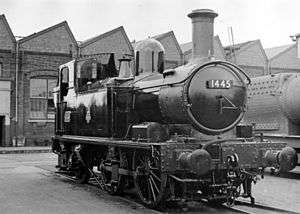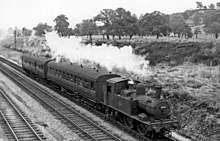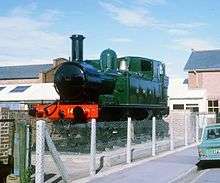GWR 1400 Class
The GWR 1400 Class is a class of steam locomotive designed by the Great Western Railway for branch line passenger work. It was originally classified as the 4800 Class when introduced in 1932, and renumbered in 1946.
| GWR 4800 class (later 1400 class) | |||||||||||||||||||||||||||||||||||||||||||||||||||||||||
|---|---|---|---|---|---|---|---|---|---|---|---|---|---|---|---|---|---|---|---|---|---|---|---|---|---|---|---|---|---|---|---|---|---|---|---|---|---|---|---|---|---|---|---|---|---|---|---|---|---|---|---|---|---|---|---|---|---|
 1445 freshly painted at Swindon Works in 1950. | |||||||||||||||||||||||||||||||||||||||||||||||||||||||||
| |||||||||||||||||||||||||||||||||||||||||||||||||||||||||
| |||||||||||||||||||||||||||||||||||||||||||||||||||||||||
| |||||||||||||||||||||||||||||||||||||||||||||||||||||||||
| |||||||||||||||||||||||||||||||||||||||||||||||||||||||||
Although credited to Collett, the design dated back to 1868 with the introduction of the George Armstrong 517 class.
Precursors
Like the 48xx/14xx, the 517 Class was a lightweight loco for branchline work; it was built at Wolverhampton Works between 1868 and 1885.
In this period evolutionary changes included:
- 517-570 – with 13 ft 7 in (4.14 m) wheelbase, inside bearings to trailing wheels, and saddle tanks built 1868-1869.
- 571-576 – with 13 ft 7 in (4.14 m) wheelbase, outside bearings and side tanks built 1869-1870
- 826-836, 838-849, 1154–1165, 202-05, 215-222, 1421–1432, 1433–1444, 1465-1482 – all with 15 ft 0 in (4.57 m) wheelbase with side tanks built 1873-1883
- 1483-1488 – with 15 ft 6 in (4.72 m) wheelbase and side tanks built 1884-1885
Later gradual changes included: Belpaire fireboxes, boilers rated at 165 psi (1.14 MPa) as opposed to 150 psi (1.0 MPa), full cabs, extended bunkers and the progressive conversion of short wheelbase locos to 15 ft 0 in (4.57 m) or 15 ft 6 in (4.72 m). From 1924 onwards, several were converted to run with an autocoach, and in this configuration were the direct ancestors of the 48xx class.
In this form, the updated 517's were but a small step away from the 48xx. The wheelbase was still 15 ft 6 in (4.72 m), the boiler still rated at only 165 psi (1.14 MPa), and the wheels 5 ft 2 in (1,575 mm) and 3 ft 8 in (1,118 mm). New was the Collett-style cab and bunker and the boiler nominally to a new design. A three bar crosshead was added to the motion. This was a 1924 innovation introduced with the GWR 5600 Class and also seen in the 1930s-built 5400, 6400 and 7400 classes of pannier tanks.
Into service

The 4800 Class was designed as a more modern version of the 517 Class, which were by then beginning to show their relative age. The first locomotive, No 4800, was built by Swindon Works and entered service in 1932, with a further seventy-four engines of this type following up to 1936. During this period, Swindon also built twenty 5800 Class engines, which were broadly similar but which were not fitted with autotrain equipment or the Swindon top feed as later fitted to a number of 4800 class engines.
The 4800 Class locomotives retained their original numbers until the GWR decided to experimentally convert twelve 2800 Class 2-8-0s for oil-firing. It was decided that the converted engines would be reclassified as the 4800 Class and so the 75 tank locomotives already carrying this designation were reclassified as the 1400 Class with running numbers 1400-1474. The engines did not revert to their original classification after the experiment ended in 1948. They could reach a maximum speed of 80 mph which was much faster than the diesel railcars designed to replace them could reach.[1]
The 1400 Class was designed to work with the GWR design of autocoach, a specialist coach designed for push-pull working and which could also be used with engines of other classes such as the 517's, the GWR 5400 Class, the GWR 6400 Class and the older GWR 2021 Class. This lack of auto gear was the cause of earlier scrapping of the 5800 Class as there was no work for them. The last, no. 5815, was withdrawn from Swindon shed in April 1961.[2]
The auto-fitted locos fared little better; scrapping commenced in 1956 and all were withdrawn by early 1965. Nos. 1442 and 1450 were withdrawn from Exmouth Junction shed in May 1965.[3] By the early 1960s several had been 'in store' (parked in an out-of-the-way siding with a tarpaulin over the chimney) for some time, being occasionally steamed to replace failed diesels.
Preservation

Four examples have been preserved, all late withdrawals from service in the 1963-1965 period. All went direct to preservation from British Railways in relatively good condition. The current location of the preserved examples is as follows:
- 1420 – South Devon Railway (under overhaul)
- 1442 – Tiverton Museum, Tiverton, Devon (static exhibit)
- 1450 - Severn Valley Railway (operational)
- 1466 – Didcot Railway Centre (under overhaul)
Known affectionately as The Tivvy Bumper, 1442 hauled the last train to Tiverton in October 1965.[4] All preserved examples apart from 1442 are fitted with auto train equipment and 1450 has also operated on the mainline in preservation, but due to its size was restricted in the amount of work it could do and was also restricted on mileage as the 1400s only have a max water capacity of 800 imp gal (3,600 l; 960 US gal). During the 1990s it worked a number of Dawlish Donkey trips from Exeter St David's to Newton Abbot.
In fiction
- A scene in the 1955 film Where There's a Will shows locomotive No. 1439 arriving at Staverton railway station.[5]
- A fictional 1400 class locomotive (Oliver the Western Engine), as No. 1436, appears in The Railway Series of children's books written by the Rev. W. Awdry, and in the spin-off TV series (Thomas the Tank Engine and Friends). For the television series, he was changed to No.11.
- Two of these engines (GWR 1401 and GWR 1450,) played prominent roles in the film The Titfield Thunderbolt. Locomotive 1401 starred as the main locomotive of the Titfield–Mallingford branch until being deliberately derailed & damaged beyond repair; locomotive 1450 (with false numberplates fitted) doubled as 1401 for some scenes, to allow double the rate of filming;[6] and a fake 14xx which carried the number 1462 had a brief role as a stolen locomotive which was later crashed into a tree.
- 1450 also appeared in The Goodies episode "Daylight Robbery of the Orient Express".
Models
- Hornby Railways manufacture a model of the 14xx in OO gauge.
- Dapol manufactured a model of the 14xx for British N gauge in 2004 but has since ended production of this model.
- DJmodels produced models of the 14xx and 48xx class locomotives in 00 gauge in 2018.[7][8]
- Dapol released a version of the 14xx in O gauge in early 2020. [9]
References
- Speller, John. "Collett Locomotives". John Speller's Web Pages. Retrieved 25 June 2020.
- Rowledge, J.W.P. (1986). GWR Locomotive Allocations: First and Last Sheds 1922-1967. Newton Abbot: David & Charles. p. 135. ISBN 0-7153-8820-7.CS1 maint: ref=harv (link)
- Rowledge 1986, p. 123
- "The Authers Gallery". Tiverton Museum. Archived from the original on 13 August 2007. Retrieved 16 October 2007.
- "Film: Where There's A Will". Reel Streets. Retrieved 30 July 2017.
- See reference at IMDB.
- http://www.hattons.co.uk/NewsDetail.aspx?id=79
- http://www.hattons.co.uk/NewsDetail.aspx?id=86
- "Welcome to Tower Models Website". www.tower-models.com. Retrieved 6 September 2017.
- Whitehurst, Brian (1973). Great Western Engines, Names, Numbers, Types and Classes (1940 to Preservation). Oxford, UK: Oxford Publishing Company. pp. 17–18, 97, 102, 166. ISBN 978-0-9028-8821-0. OCLC 815661.
External links
| Wikimedia Commons has media related to GWR 1400 Class. |
- The Great Western Archive – 1400 class
- South Devon Railway - Details of no. 1420 (includes drawing and specifications)
- GWR 14xx Class - Past & Present (includes operating history of the preserved examples)